
Opabinia regalis is an extinct, stem group arthropod found in the Middle Cambrian Burgess Shale Lagerstätte of British Columbia. Opabinia was a soft-bodied animal, measuring up to 7 cm in body length, and its segmented trunk had flaps along the sides and a fan-shaped tail. The head shows unusual features: five eyes, a mouth under the head and facing backwards, and a clawed proboscis that probably passed food to the mouth. Opabinia probably lived on the seafloor, using the proboscis to seek out small, soft food. Fewer than twenty good specimens have been described; 3 specimens of Opabinia are known from the Greater Phyllopod bed, where they constitute less than 0.1% of the community.

Canadaspis is an extinct genus of bivalved Cambrian arthropod, known from North America and China. They are thought to have been benthic feeders that moved mainly by walking and possibly used its biramous appendages to stir mud in search of food. They have been placed within the Hymenocarina, which includes other bivalved Cambrian arthropods.

Waptia is an extinct genus of arthropod from the Middle Cambrian of North America. It grew to a length of 6.65 cm (3 in), and had a large bivalved carapace and a segmented body terminating into a pair of tail flaps. It was an active swimmer and likely a predator of soft-bodied prey. It is also one of the oldest animals with direct evidence of brood care. Waptia fieldensis is the only species classified under the genus Waptia, and is known from the Burgess Shale Lagerstätte of British Columbia, Canada. Specimens of Waptia are also known from the Spence Shale of Utah, United States.
A number of assemblages bear fossil assemblages similar in character to that of the Burgess Shale. While many are also preserved in a similar fashion to the Burgess Shale, the term "Burgess Shale-type fauna" covers assemblages based on taxonomic criteria only.

Chuandianella ovata is an extinct bivalved arthropod that lived during Cambrian Stage 3 of the Early Cambrian. It is the only species classified under the genus Chuandianella. Its fossils were recovered from the Chengjiang Biota in Yunnan, China.
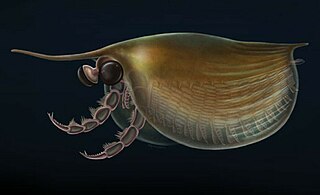
Isoxys is a genus of extinct bivalved Cambrian arthropod; the various species of which are thought to have been freely swimming predators. It had a pair of large spherical eyes, and two large frontal appendages used to grasp prey.

Kuamaia is an extinct genus of artiopodan in the phylum Arthropoda. Fossils of the type species K. lata were discovered in the Chengjiang biota. The other species in the genus,K. muricata has also been identified there, but neither species has been found elsewhere.

Pectocaris is a extinct genus of bivalved arthropods from the Cambrian Maotianshan Shales, Yunnan Province of China. There are currently three known species within the genus.

Kiisortoqia soperi is an extinct species of arthropod from the Early Cambrian Sirius Passet Lagerstätte in Greenland. While it had a superficially trilobite-like bodyform, it also possessed large frontal appendages similar to those of radiodonts.
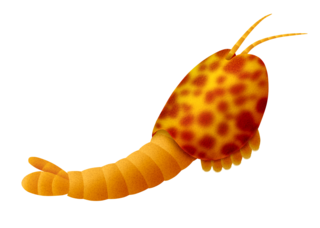
Pauloterminus is an extinct genus of bivalved arthropod known from Early Cambrian Sirius Passet locality of northern Greenland. It is tentatively classified under the family Waptiidae.

Aaveqaspis is a genus of small marine arthropods of unclear affiliation, that lived during the early Cambrian period. Fossil remains of Aaveqaspis were collected from the Lower Cambrian Sirius Passet fossil-Lagerstätte of North Greenland. Aaveqaspis looks like a soft eyeless trilobite with a weakly defined axis, a headshield with stubby genal spines, 5 thorax segments also ending in stubby genal spines, and a tailshield (pygidium) with a pair of massive tusk-like spines, and two smaller spines near the end of the axis. The only species presently known is A. inesoni.

Buenaspis is a genus of small nektaspid arthropod, that lived during the early Cambrian period. Fossil remains of Buenaspis were collected from the Lower Cambrian Sirius Passet Lagerstätte of North Greenland. Buenaspis looks like a soft eyeless trilobite. It has a headshield slightly larger than the tailshield (pygidium), and in between them six thoracic body segments (somites). The genus is monotypic, its sole species being Buenaspis forteyi.

The Artiopoda is a grouping of extinct arthropods that includes trilobites and their close relatives. It was erected by Hou and Bergström in 1997 to encompass a wide diversity of arthropods that would traditionally have been assigned to the Trilobitomorpha. Trilobites, in part due to their mineralising exoskeletons, are by far the most diverse and long lived members of the clade, with most records of other members, which lack mineralised exoskeletons, being from Cambrian deposits.

Squamacula is an extinct artiopodan arthropod from the Cambrian Series 2. The type species S. clypeata was described in 1997 from the Chengjiang biota of Yunnan, China. At the time of description there were only two known specimens of S. clypeata, but now there are at least six known specimens. In 2012 a second species S. buckorum was described from the Emu Bay Shale of Australia.
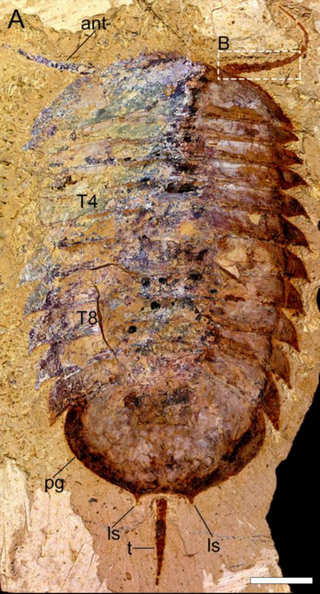
Retifacies is an extinct arthropod that lived in the lower Cambrian. Its fossil remains have been found in the Maotianshan Shales of Yunnan, China. It is a member of the Artiopoda, and closely related to Pygmaclypeatus.
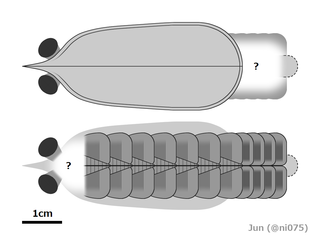
Erratus is an extinct genus of marine arthropod from the Cambrian of China. Its type and only species is Erratus sperare. Erratus is likely one of the most basal known arthropods, and its discovery has helped scientists understand the early evolution of arthropod trunk appendages. Some of the stem-arthropods like radiodonts did not have legs, instead they had flap like appendages that helped them swim. Erratus on the other hand had not only flaps but also a set of primitive legs. It also supported the theory that the gills of aquatic arthropods probably evolved into the wings and lungs of terrestrial arthropods later in the Paleozoic.

Jugatacaris is an extinct genus of bivalved arthropod known from a single species, Jugatacaris agilis found in the Cambrian Stage 3 aged Chengjiang biota of Yunnan, China. The carapace is around 28 to 37 millimetres in length, with a pronounced ridge at the top of the carapace separating the two valves, which formed a fin-like structure raised above the carapace. The head has a pair of stalked eyes, as well as a dumbbell shaped medial eye between them. The head also bore a pair of mandibles as well as at least one and possibly two pairs of antennules. The trunk had up to 65 segments, each with biramous appendages. The appendages had thin endopods with 30 podomeres, each bearing a spiny endite, with the endopods ending with a terminal claw. The appendages also had overlapping flap-like exopods, which are elongated, being at maximum eight times as long as they are wide, which on their posterior edge are covered with setae. The trunk ended with a forked tail. It was likely an actively swimming filter feeder, using its constantly beating appendages to sift food from the water column, which was then passed forward along the U-shaped food groove between the appendage pairs towards the mouth. While initially placed as a crustaceanomorph, later studies considered to be a member of Hymenocarina, which contains numerous other similar bivalved Cambrian arthropods.
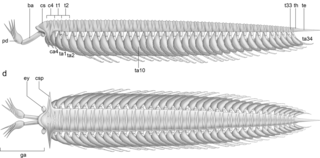
Sklerolibyon is an extinct genus of megacheiran arthropod, known from the Cambrian aged Chengjiang biota of Yunnan, China. It is a member of the family Jianfengiidae, alongside Jianfengia and Fortiforceps, and possibly also Parapeytoia. Specimens are around 2.5 centimetres (0.98 in) in length. The body is greatly elongated, and head shield is heavily sclerotised, with a pair of spines radiating outward from the sides. Alongside the pair of great appendages, there are a pair of stalked eyes and at least two other pairs of limbs on the cephalon. The trunk has 34 segments with corresponding biramous appendages, with typically megacheiran paddle-shaped exopods. The tail is unknown but like Jianfengia probably ended in a telson spine.

Fortiforceps is an extinct genus of Cambrian megacheiran arthropod known from the Chengjiang biota of Yunnan, China. It was originally described by Hou and Bergström in 1997, and redescribed in 2020. It was relatively small, at 4 centimetres (1.6 in) or less in length. The head had a large pair of stalked eyes, a pair of frontal projections, as well as a pair of great appendages, like other megacheirans, along with two other cephalic appendages. The trunk had either 20 or 22 segments, depending on the specimen. These segments had pronounced blade-like spines on their upper-outer edge. Each of the trunk segments were associated with pairs of biramous limbs, which probably have seven podomeres and like other megacheirans, have paddle-shaped exopods. The trunk terminated with a forked tailpiece, which on their outer edges had rod-like structures. The two lobes were separated by a rectangular central piece. It has been placed as a member of the family Jiangfengiidae, alongside Jianfengia, Sklerolibyon and possibly Parapeytoia.

Carimersa is an extinct genus of artiopodan arthropod known from the Silurian Coalbrookdale Formation of Herefordshire, England.



















